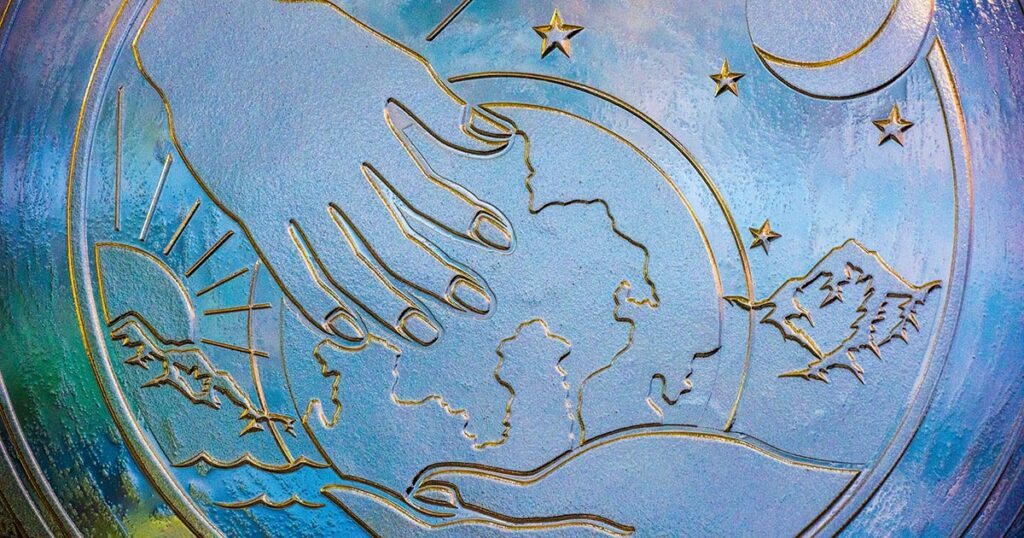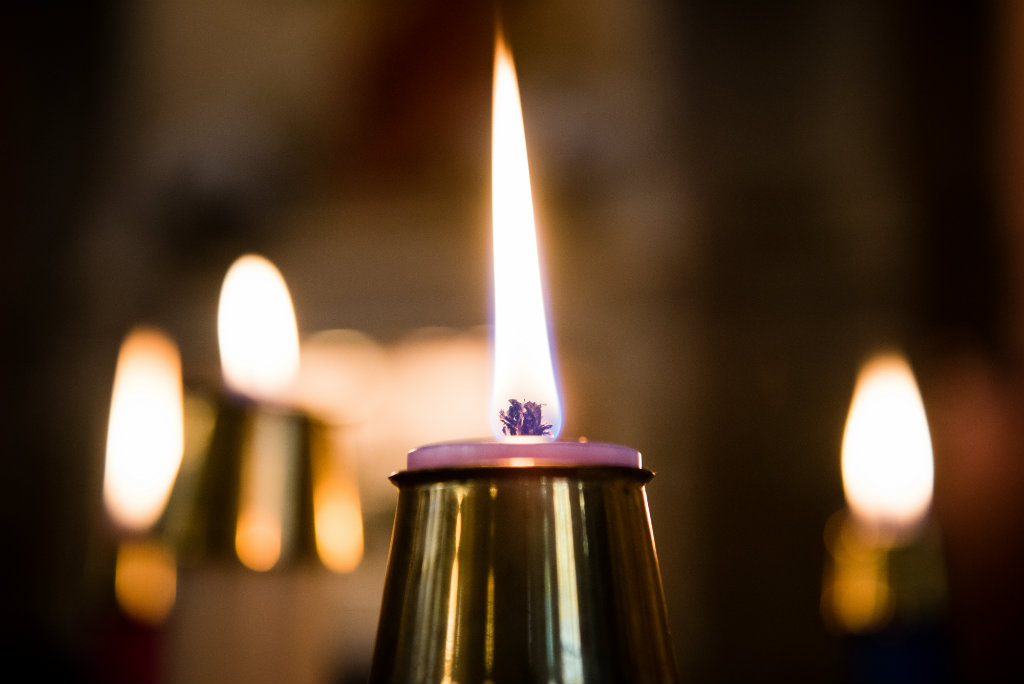by Stacey Egger
We live in a world without night. That is, we live with so many technologies to keep the fall of darkness from hindering our activity and productivity that the transition between daylight and nighttime — at least for us city dwellers (83% of Americans in 2018) — interests us casually, if at all.
No stray beam of sunlight reaches the desk where I work in the inner reaches of a large office building. Nor do I have need of one. The fluorescent lights above me shine changelessly over me and my work. A few times, usually in the week or two after we “fall back” an hour, I have left the office expecting to walk out into evening light, only to find myself exiting into total night, no hint of sunset on the horizon, the sky as black as it will be all night in the St. Louis metro area. A quick glance would reveal a dozen or two stars winking at me from above. I have worked right through the sunset without the least hindrance or notice.
Long before fluorescent lights, flashlights, streetlights or corporate office buildings, Christians gathered to sing praises to our God and theirs — in the morning, in the daytime and often as night fell. At some point in the seventh or eighth century, as they gathered together on evenings during Advent (as we do) to sing praises to the Christ whose second coming they awaited (as we do), they began to sing a chant in Latin, written for Advent Vespers, called Conditor alme siderum. We know this text in English as “Creator of the Stars of Night,” one of our beloved Advent hymns included in Lutheran Service Book (351).
Thou cam’st the Bridegroom of the bride, As drew the world to eventide …
How different their experience of eventide must have been, over a millennium ago. Our logistical difficulties with an evening church service include things like getting ourselves up off the couch an hour after arriving home from work. We flip a switch to ignite the church’s light fixtures and the 8,000 tiny bulbs on the tree in the corner.
As night fell in the seventh century, light for the next 10 or 15 hours meant fire. Lighting the sanctuary meant candles, torches, lanterns. Creating and maintaining light after nightfall involved great effort, not to mention some danger.
And yet, God did not leave our forebears quite to their own devices. As darkness fell, the moon rose, the evening star blinked on and the whole heavenly host followed thereafter. These lights were not as bright as the sun. They did not prevent night from being dark. But compared to total darkness, they were everything. They were light. And in contrast to the labor of tending fire, these lights from the sky were clearly, wondrously, gifts of God.
Creator of the stars of night, Thy people’s everlasting Light: O Christ, Redeemer, save us all, And hear Thy servants when they call.
It seems quite natural that people daily beset by darkness would so readily praise God for His being Light (1 John 1:5). Yet what is meant by “Light” here, and what is this redemption that Christ’s people need? The second stanza fills us in:
Thou, grieving that the ancient curse Should doom to death a universe, Hast found the healing, full of grace, To cure and save our ruined race.
The third stanza goes on to tell the story of this cure:
Thou cam’st the Bridegroom of the bride, As drew the world to eventide, The spotless Victim all divine, Proceeding from a virgin shrine.
The hymn moves quite seamlessly from Christ (to whom the whole hymn is addressed) as Creator of light to Christ Himself as the Light of the world. In fact, there really is no “move” at all: The text does not read as if God as Light is merely an image, a way of picturing the redemption of the world, but as if God as Light is literal[1] — not only in the past, back in the manger and on Easter morning, or even today in the forgiveness of our sins only, but also this morning when the sun rises, this evening when the stars and the moon come out. Christ is, literally, the light of the world.
The hymn reminds us, on the other hand, that just as God formed the day and night to be habitable and beautiful to His creatures, so He directs all of history through His providence. The stars reflect God’s good will toward us and His creative order in all things, including our salvation. When we read the Old Testament and reflect on salvation history, we can be tempted to wonder: Why did Christ wait so long to come down to earth and save us? And just so we wonder, often during Advent: Why has He taken so long to return? What is He waiting for? This hymn comforts us on these points by reminding us of Christ as Creator. Each night the lights in the heavens appear just when they are needed. Just so was God’s timing with the coming of Christ. As the world turned to evening, Christ the star emerged in our sight. “When the fullness of time had come, God sent forth his Son, born of woman” (Gal. 4:4). And just so will be Christ’s return. It will come at the right time — the right time for us.
What a loving and beautiful reflection on Christ’s faithfulness and care for us we gain from our brothers and sisters of centuries ago and the immediacy with which they encountered God’s creation. Nightfall made dependence on Christ particularly evident to these early Christians. Pondering this hymn, we may wonder how our own technologically enabled distance from the created world might blind us to the status as dependent creatures which was so palpable to our ancestors in the faith. We have wrought our own “everlasting lights,” and promptly forgotten about them. As a city dweller, my path is lit for me 24 hours a day, should I choose to venture out, and only in relation to my electric bill do I spare a thought for the origin of this light. Even in secular psychology, studies are again and again suggesting the profound (spoiler: negative) psychological affects that light pollution is having on human beings. It is a strong image, and one that may launch many reflections on our technological advancements, that our fending off of the night has so nearly blotted out our vision of God’s created lights.
Perhaps, indeed, this is worth reflecting on — but not for too long. This month’s issue of The Lutheran Witness discussed anthropology, that is, the study of what it means to be human. If we see ourselves as fundamentally defined by our environment, we may find our sense of self looking rather bleak and isolating. How are we to understand ourselves in a world that has come so far from the days of Christ, from the days of the apostles, from the simpler world that led to the penning of “Creator of the Stars of Night”? How can faith survive in such a blind and blinding world? What do we share with these people who lived in a world so much more visibly God’s?
Yet think of this: We still sing this hymn. We may never have been able to write it; we may skip right over the weight of the first line, hearing something akin to “God makes pretty things,” and yet for most of the hymn we track right along with our kindred people of a millennium ago.
After singing of Christ as Creator and Redeemer, the hymn sings of Christ Enthroned:
At whose dread name, majestic now, All knees must bend, all hearts must bow; All things celestial Thee shall own, And things terrestrial, Lord alone.
This stanza speaks of a particular era in salvation history, one in which those who wrote the text lived and the very same in which we live. As the stars confess Christ their Creator, so “things terrestrial” — we — confess Him. So Christians of the seventh and eighth century, huddled together by candlelight, sang of Him; so we sing of Him on Wednesday nights in Advent under electric lightbulbs: our King and theirs.
Finally, the hymn moves on to another coming of Christ, the one that they anticipated and that we still anticipate today:
O Thou, whose coming is with dread, To judge the living and the dead, Preserve us from the ancient foe While still we dwell on earth below.
We face the same foe that these Christians did, one far more ancient even than they. With them, we are hopeless against that foe save by the preservation of our God. With them, we await Christ’s second coming.
What we are fundamentally is what they were, what we will be as unknown to us as it was to them: “We are God’s children now, and what we will be has not yet appeared; but we know that when he appears we shall be like him, because we shall see him as he is” (1 John 3:2). What we are and what we will be is in the hands of God, who created us from clay in His image, who redeemed that image in the incarnation and death of His Son, who preserves us now in the ark of His church. We await with the church of all ages the day of Christ’s judgement, when together with them we will sing praise to Him in that place where “night will be no more,” where “they will need no light of lamp or sun, for the Lord God will be their light” (Rev. 22:5). Only under that everlasting light will mankind be changed, on that day when all that man has wrought over the centuries will fall away as dust, and we will stand as one people before the throne of God.
[1] See Hayden Lukas, “Light: Recovering an Ancient Perspective,” Grapho 4.1 (2022), 54–63.
Photo: LCMS Communications/Erik M. Lunsford





Jesus said, “I am the light of the world. Whoever follows me will not walk in darkness, but will have the light of life” (John 8:12 ESV).
These things are associated: light, love, wisdom, truth, sight, safety, joy and life.
Their opposites are darkness, hate, foolishness, falsehood, blindness, danger, despair and death.
In all circumstances this side of heaven, we have reason to pray, “Lord, I want to see” (Luke 18:41 NIV).